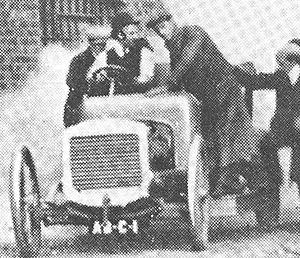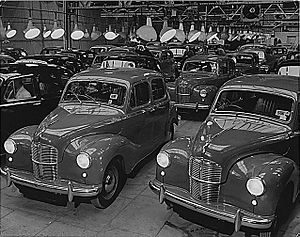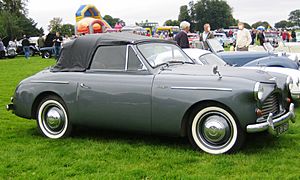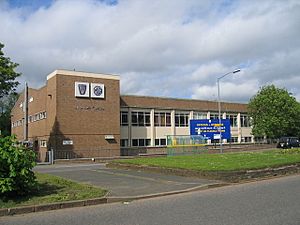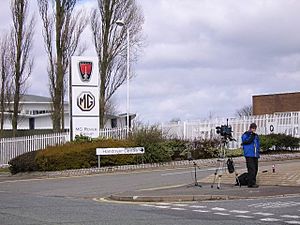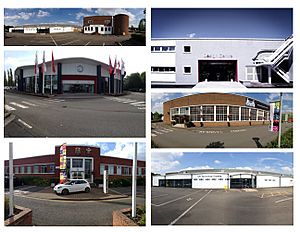Longbridge plant facts for kids
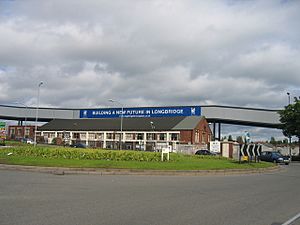
Longbridge in 2006
|
|
| Built | 1895 |
|---|---|
| Location | Longbridge, Birmingham, England |
| Industry | Car making |
| Products |
|
| Employees |
|
| Architect | Herbert Austin |
| Style | Manufacturing, industrial centre/plant |
| Area | 69 acres (28 ha) (Remaining) |
| Address | MG Motor, Lowhill Lane, Longbridge, Birmingham B31 2BQ |
| Owner(s) | Austin Motor Company (1906-1952) British Motor Corporation (1952-1968) British Leyland (1968-1986) Rover Group (1986-2000) MG Rover Group (2000-2005) SAIC (2005- present) |
The Longbridge plant is a large industrial area in Longbridge, Birmingham, England. It is currently used by SAIC for research and development for its MG Motor car brand. Car assembly at the plant stopped in 2016.
The factory first opened in 1905. By the late 1960s, about 25,000 people worked there. They built famous cars like the original Mini.
During the Second World War, the main factory made weapons and tank parts. A nearby part of the factory, Austin Aero Ltd, built Short Stirling and Hawker Hurricane aircraft.
After the car company MG Rover closed in 2005, parts of the site were rebuilt. Now, there are shops, homes, and other businesses there.
Contents
The History of Longbridge Cars
How the Factory Started
Early Days: 1895–1901
The land for the factory was first bought by a printing company called White and Pike Ltd. They wanted to build a big new factory for printing. They chose a large area of farmland in Longbridge, south of Birmingham.
The factory was built and opened in 1895. But the printing business did not do well. The bank took over the site in 1901.
Austin Takes Over: 1906–1914
Herbert Austin was a clever engineer who had worked in Australia. He returned to England and helped start a big car company. In 1905, he decided to start his own car company.
He found the empty printing factory in Longbridge. With help from friends and other companies, Austin bought the site in January 1906.
Austin and his first workers moved into the factory even before he officially bought it. He wanted to show his new car at a big car show in London in November 1906. The first Austin car was a large touring car. It was finished in March 1906 and cost £650.
In the first year, about 50 people worked there and made about 12 cars. By 1908, 1,000 workers were at the factory. They even started a night shift to make more cars. By 1912, the factory was much bigger, making 1,000 cars a year with 1,800 employees.
The factory started making its own car bodies and wheels. In 1914, the company became a public company. This meant they could get more money to build new workshops. They also changed the factory to use electricity instead of old mechanical systems.
Longbridge During World War I
When World War I started, the Longbridge factory quickly changed. Instead of making cars, the machines were used to make weapons and equipment for the army.
The factory grew much bigger to meet the demand for war supplies. A new Longbridge railway station was built inside the factory grounds. This allowed trains to bring workers directly from Birmingham New Street.
By 1917, the factory was three times its original size. It even had its own flying field nearby for testing aircraft. Many women worked at the factory during the war. The number of employees grew to over 22,000.
Between 1914 and 1918, the factory made millions of shells, guns, aeroplanes, and trucks. Because of this important work, Herbert Austin was made a knight in 1917.
North Works Expansion: 1917
To make even more war supplies, the company bought a farm north of the main factory. This became known as the Longbridge North works. They built huge new workshops there. This included a large machine shop, a forge, and a big dining hall for 4,000 workers. They also built a power house to supply electricity to the new areas.
After the War: 1919
When the war ended suddenly in 1918, the factory was huge. It was making only war products. All the war contracts were cancelled very quickly.
The factory now had a large steel foundry and big shops for pressing metal and heat-treating parts. These were all new additions from the war.
The Years Between the Wars
Before the war ended, plans were made to focus on making a 20 horsepower car. The engine from this car was also used for an Austin tractor. This tractor won many farming awards. A large 13-ton truck also used the same engine.
For a short time, Austin also made some aeroplanes after the war. But after 1921, Herbert Austin became interested in smaller vehicles. He created the tiny and very popular Austin 7. This car was a smaller version of his earlier designs.
Longbridge During World War II
When World War II began, the factory was again used for the war effort. Car making mostly stopped. The machines were used to make ammunition for antitank guns. They also made steel boxes, jerrycans, mines, depth charges, and helmets.
Longbridge also made parts for tanks. Aircraft were built at a special "shadow factory" nearby in Cofton Hackett. This included Fairey Battle bombers, Mercury and Pegasus engines, and Short Stirling bombers. They also built Hawker Hurricane fighter planes. Nearly 3,000 aircraft were built there.
The factory was a very important target for enemy bombers. The Germans tried to bomb Longbridge, but sometimes missed.
After World War II
After the war, Leonard Lord became the chairman. He planned to quickly expand the factory, make new car models, and sell cars overseas. In June 1946, the one millionth Austin car was made. It was a special celebration.
Austin worked with other companies to make new cars. They worked with Jensen Motors on the Austin A40 Sports. They also worked with the Donald Healey Motor Company on the Healey 100.
In 1952, Austin joined with Morris Motors Limited. They became a new company called BMC.
Later, in 1968, the government arranged for BMC to join with other companies. This created British Leyland.
Government Ownership
The British Leyland company faced money problems. In 1975, the government helped them by putting money into the company. This made the government the main owner.
During the 1970s, many strikes affected production at Longbridge. These strikes caused problems for the factory.
In 1979, Longbridge was expanded to make a new small car. This car was launched in 1980 as the Austin Metro. The Metro was made for 10 years and became one of the most popular cars from the plant. New buildings were added, and robots were used for the first time in British Leyland. Car bodies were built in one area and then moved by a covered conveyor belt over the road to another area for final assembly. This system was used until car production stopped in 2005.
Selling Off and Closing Down
By the 1980s, British Leyland had become much smaller. Many of its businesses and factories had closed or been sold. The company also started working with a Japanese company called Honda. This helped British Leyland and gave Honda a way to sell cars in the UK.
The Austin Metro was the most successful car made at Longbridge in the late 1900s. It was introduced in 1980. In 1990, it was updated and renamed under the Rover brand.
In 1988, the Longbridge plant and the rest of Austin Rover were sold to British Aerospace. They renamed the company the Rover Group in 1989.
In 1989, a new car called the second-generation Rover 200 was launched. It was built at Longbridge. This car was very popular in Britain. It was replaced by new models in 1995.
In 1994, the German car company BMW bought the Rover Group and the Longbridge plant. But BMW lost a lot of money with Rover. In 2000, BMW sold Rover Cars and the Longbridge factory to a group called the Phoenix Consortium. They renamed it MG Rover Group. They bought it for a very small amount of money.
Many people thought the factory was too old and the company would run out of money. In April 2005, this happened. MG Rover Group went out of business. More than 6,000 workers lost their jobs. One reason was that MG Rover had not launched a completely new car model in over six years. Other car companies were releasing new models all the time.
Chinese Ownership: Nanjing and SAIC
A Chinese car company called Nanjing bought the remaining parts of MG Rover. This included the right to use the Longbridge plant. In August 2008, production of the MG TF car restarted. This was three years after MG Rover closed. Only a small part of the old factory was used.
Most of the rest of the factory site was sold off and cleared. The land was used to build new homes and businesses. The goal was to create 10,000 jobs and 1,450 homes.
Nanjing Automotive Corporation was bought by another Chinese company, Shanghai Automotive Industry Corporation (SAIC), in 2007-2008. This meant SAIC now owned the Longbridge site. In 2008, SAIC moved its UK engineering team to Longbridge. In 2010, they showed off their new engineering and design studio there.
Engineers at Longbridge worked on the MG 6 car. In April 2011, MG Motors started making the MG 6 at Longbridge. The cars arrived from China almost complete. Workers at Longbridge only fitted the engine, front suspension, front trim, and wheels. The factory no longer had areas for welding car bodies or painting them. Production of the MG TF stopped around this time.
Production of the MG 3 car started at Longbridge in 2012. By 2014, about 400 people worked at the plant.
On September 23, 2016, MG announced that all car production at Longbridge had stopped. Now, all MG cars sold in the UK are imported from other countries.
Starting in January 2020, the last remaining assembly buildings at Longbridge were mostly taken down. This was to make space for more new houses. The former production area is now only used for selling cars and for research and development of future models.
Popular Culture
Just before MG Rover closed in 2005, the music video for "Believe" by The Chemical Brothers was filmed inside the Longbridge factory.
Also, pictures from the Longbridge production line and of the Mini car were used to introduce the United Kingdom's entry in the 1998 Eurovision Song Contest. That year, the contest was held in Birmingham.
The Longbridge plant is mentioned in the novel The Rotters' Club and its follow-up books, The Closed Circle and Middle England, by Jonathan Coe. Some characters in these books work at the factory.


